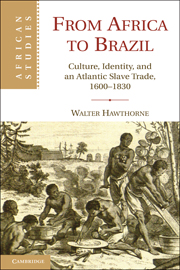Book contents
- Frontmatter
- Contents
- List of Figures
- List of Maps
- List of Tables
- Abbreviations Used in Notes
- Acknowledgments
- Introduction
- PART I THE WHY AND HOW OF ENSLAVEMENT AND TRANSPORTATION
- 1 From Indian to African Slaves
- 2 Slave Production
- 3 From Upper Guinea to Amazonia
- PART II CULTURAL CHANGE AND CONTINUITY
- Index
- References
3 - From Upper Guinea to Amazonia
Published online by Cambridge University Press: 05 September 2012
- Frontmatter
- Contents
- List of Figures
- List of Maps
- List of Tables
- Abbreviations Used in Notes
- Acknowledgments
- Introduction
- PART I THE WHY AND HOW OF ENSLAVEMENT AND TRANSPORTATION
- 1 From Indian to African Slaves
- 2 Slave Production
- 3 From Upper Guinea to Amazonia
- PART II CULTURAL CHANGE AND CONTINUITY
- Index
- References
Summary
In February 1756, the Portuguese galley São José was anchored in the river off Cacheu, the ship’s crew filling it with slaves who had been shuttled in canoes a short distance from shore. The São José was one of the first ships of the Company of Grão Pará and Maranhão (CGPM) to arrive on the Upper Guinea coast. Since 1755, the CGPM had had a monopoly on trade flowing from Bissau and Cacheu and into the ports of São Luís and Belém, the capitals of the Brazilian captaincies of Maranhão and Pará in the northern Amazonia region. The monopoly was ended in 1778 with the company continuing to trade in a freer market through 1787. As slaves were loaded into canoes, a priest sprinkled each of them with water and spoke a few incomprehensible words. He, too, assigned the slaves Christian names – José, João, Roberto, Sebastián, Maria, Catharina, Brizida, Roza, and so on. Those the Portuguese called gentio (which can be translated as “savages” or “pagans”) were baptized – introduced to Christianity and Western “civilization.”
There was nothing unusual about the manner in which slaves were embarked on the ship. Nothing, that is, except for the fact that a scribe took time to record slaves’ baptismal names and ethnicities. Initially, a total of ninety-seven people (seven of whom were infants) were forced onto the vessel. The infants were listed in the ship’s records without value and were carried by their mothers as filhos de peito, “nursing children.” Fifty-seven percent of those whose ethnicities were recorded had been taken from the immediate coastal region of Upper Guinea, only tens of miles from the ports of Bissau and Cacheu. The ethnicities they claimed were Balanta, Bijago, Papel, Floup, Banhun, and Brame. The remaining 43 percent were Mandinka, who were from farther inland. Just before the São José departed, another few captives were added to the vessel, bringing the total number of slaves of monetary value to the CGPM to ninety-four. Those who survived the passage to Pará probably spent about fifty days together on the ocean.
- Type
- Chapter
- Information
- From Africa to BrazilCulture, Identity, and an Atlantic Slave Trade, 1600–1830, pp. 97 - 134Publisher: Cambridge University PressPrint publication year: 2010



